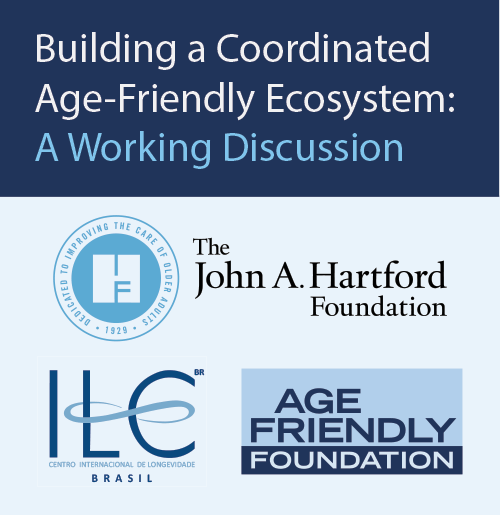On March 10, 2021, 40+ recognized leaders who are working to advance age-friendly initiatives in public health, health systems, community, academia and employment gathered for the second of three virtual working sessions to discuss shared characteristics and measures in their work. Participation was by invitation only. 25 organizations representing 6 countries were included.
Goals
Part 1 of the series on 12/16/20: The goal of this event was to begin discussing shared characteristics and to introduce measures of collective impact.
Part 2 of the series on 03/10/21: The goal of this second event was to build upon our work in December by exploring areas for collaboration across sectors and beginning to identify measures that can be aligned across age friendly settings.
Introductory Remarks
Event moderator, Dr. Alice Bonner opened the second meeting reminding attendees that our purpose together was to begin a dialogue about what we can do across initiatives to build momentum for age friendly work in all settings, how can we, together, elevate the term age friendly to make sure it really means something that people and organizations can build on and how we can we, together, begin to establish shared understandings about an Age-Friendly Ecosystem: language to describe it, opportunities to pursue it, and ways to measure its impact.
Guest Speaker and patient advocate Randel Smith also joined the working discussion on March 10 to talk to the group about the varied experiences of getting vaccinated in his hometown in Maryland.
Modifications to the Shared Characteristics of an Age-Friendly Ecosystem
Dr. Kim Dash and Jody Shue led a discussion about the development of shared understandings of an Age-Friendly Ecosystem in order that it can become an actionable roadmap for practitioners. For the first meeting, a proposed framework of those understandings was created, and then updated based upon the feedback that was received at that time. Descriptive characteristics have been modified, as have the examples of the kinds of framework specific programming that aligns with these characteristics. The revisions to the shared characteristics framework were implemented based upon feedback from this working group at the first convening in December, 2020.
After the presentation of the Shared Characteristics of an Age-Friendly Ecosystem, updates to the Indicator and Measures Matrix and survey results about potential areas for collaboration, attendees were asked to engage in small group breakout room discussions to specifically engage their input regarding opportunities for collaboration across age-friendly settings.
A full write up from the meeting can be found HERE.

